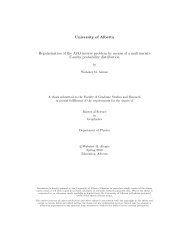Soner Bekleric Title of Thesis: Nonlinear Prediction via Volterra Ser
Soner Bekleric Title of Thesis: Nonlinear Prediction via Volterra Ser
Soner Bekleric Title of Thesis: Nonlinear Prediction via Volterra Ser
Create successful ePaper yourself
Turn your PDF publications into a flip-book with our unique Google optimized e-Paper software.
5.2. PREDICTION ERROR OPERATOR 77<br />
Simple reflection<br />
Ghost<br />
Short − Path Multiples Long − Path Multiples<br />
Near−surface<br />
multiple<br />
Peg−Leg<br />
Multiple<br />
(Type I)<br />
Near−surface<br />
multiple<br />
Peg−Leg<br />
Multiple<br />
(Type II)<br />
Figure 5.1: Multiple types. After Sheriff (2006) .<br />
Double<br />
multiple<br />
events. In this case, the assumption <strong>of</strong> predictability <strong>of</strong> waveforms in the f − x<br />
domain is not valid and consequently the algorithm fails to attenuate the multiples<br />
(Abma et al., 2005). Our extension <strong>of</strong> Spitz (1999) method to use the <strong>Volterra</strong><br />
series aims to solve this problem. I assume that the predicted multiples differ from<br />
the true multiples mainly in the wavelet and a possible time shift with respect to<br />
the multiples in the data panel.<br />
5.2 <strong>Prediction</strong> Error Operator<br />
From the multiple panel one can compute prediction error filters <strong>of</strong> the form<br />
f =<br />
⎡<br />
⎢<br />
⎣<br />
1<br />
−m<br />
⎤<br />
⎥<br />
⎦ . (6.1)









